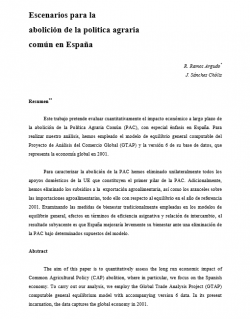Scenarios for abolition of common agricultural policy in Spain
DOI:
https://doi.org/10.35319/lajed.200912164Keywords:
Computable General Equilibrium, Common Agricultural Policy, Agricultural international trade, GTAPAbstract
The aim of this paper is to quantitatively assess the long run economic impact of Common Agricultural Policy (CAP) abolition, where in particular, we focus on the Spanish economy. To carry out our analysis, we employ the Global Trade Analysis Project (GTAP) computable general equilibrium model with accompanying version 6 data. In its present incarnation, the data captures the global economy in 2001.
To characterise abolition of the CAP we unilaterally remove all pillar one CAP support. In addition, we eliminate export subsidies and EU import tariffs which affect primary agriculture and food processing sectors, all of it according to the benchmark equilibrium in 2001.
Examining traditional general equilibrium welfare measures of market efficiency and terms of trade effects, our underlying result is that Spain realises a small welfare gain from removal of the CAP, although this finding carries a caveat.
Downloads
References
Arnalte, E. (2002). PAC y desarrollo rural: una relación de amor-odio. Información Comercial Española 803: 45-60.
Atance Muñiz, I., Gómez-Limón Rodríguez, J.A. y Barreiro Hurlé, J. (2006). El reto de la multifuncionalidad agraria: oferta de bienes privados y públicos en el sur de Palencia. Revista Española de Estudios Agrosociales y Pesqueros 210: 1-44.
Barceló, L.V. (1989): «La reducción del proteccionismo agrario. Exigencia del sistema y deseabilidad social». Información Comercial Española, 666: 15-43.
Bouët, A., Bureau, J.C., Decreux, Y. y Jean, S. (2005). Multilateral Agricultural Trade Liberalisation: The Contrasting Fortunes of Developing Countries in the Doha Round. World Economy 28(9): 1329-1354.
Burfisher, M. (ed.) (2001). The Road Ahead: Agricultural Policy Reform in the WTO- Summary Report. Agricultural Economic Report, nº 797. Economic Research Service, U.S. Department of Agriculture, Washington, D.C.
Casado, J.M. y Gracia, A. (2004) ¿Hacia un nueva PAC? Modelo español de simulación econométrica de políticas agrarias (SEPA), Documento de Trabajo 04/5, Centro de Investigación yTtecnología Agroalimentaria de Aragón.
Elfkih, S. y Sánchez Chóliz, J. (2005). Impacto socioeconómico y ambiental de la nueva PAC. Repercusiones sobre la agricultura de regadío en los Monegros (Aragón). Revista Española de Estudios Agrosociales y Pesqueros 208: 11-39.
García Alvarez-Coque, J.M., Castellano, E., y Sancho, M. (1999). Los efectos distributivos de la PAC y la cohesión. Un punto de vista mediterráneo. Revista Asturiana de Economía 14: 51-71.
Garcia Alvarez-Coque, J.M. y Valdes, A. (1997). Las tendencias recientes del comercio mundial de productos agrarios. Interdependencia entre flujos y politicas. Una síntesis. Revista Española de Estudios Agrosociales y Pesqueros 181: 9-30.
Gómez, A. (2002). Simulación de políticas económicas: los modelos de equilibrio general aplicado. Papeles de trabajo del Instituto de Estudios Fiscales. Serie economía nº 35: 1-28.
Hertel, T.W. (ed) (1997). Global Trade Analysis: Modelling and Applications. Cambridge University Press, New York.
Hubbard, L.J. (1995). General Equilibrium Analysis of the CAP using the GTAP Model. Oxford Agrarian Studies 23(2): 163-176.
Huff, K. y Hertel, T. (2001). Decomposing Welfare Changes in GTAP. GTAP Technical Paper No. 05. www.agecon.purdue.edu/gtap/.
Massot Martí, A. (1998). Hacia una nueva política rural integrada en una Europa abierta. Revista Española de Economía Agraria 182(1): 9-73.
Massot Martí, A. (2003). La Reforma de la PAC de 2003: hacia un nuevo modelo de apoyo para las explotaciones agrarias. Revista Española de Estudios Agrosociales y Pesqueros 199: 11-60.
Neville-Rolfe, E. (1984): The Politics of Agriculture in the European Community. Policy Studies Institute. Londres.
O’Ryan, R. de Miguel, C. y Millar, S. (2000): Ensayo sobre Equilibrio General Computable: teoría y aplicaciones. Documento de trabajo, Universidad de Chile.
Pañeda, C. (1999): Teoría e historia de la PAC». Revista Asturiana de Economía, 14: 7-25. Pérez, I. y Weick, C. (2004) Welfare Distribution between EU Member Status Through Different Nacional Decoupling Options – Implications for Spain, V Congreso Nacional de Economia Agraria, Santiago de Compostela, 15 - 17 Septiembre.
Philippidis, G and Hubbard, L.J. (2001). The economic cost of the CAP revisited.Agricultural Economics 25: 375-385.
Philippidis, G. and Hubbard, L.J. (2003). Agenda 2000 Reform of the CAP and its Impacts on Member States: A note. Journal of Agricultural Economics 54(3): 479-486.
Rausser, G.C. y Irwin, D.A. (1989). The political economy of agricultural policy reform.European Review of Agricultural Economic 15(4): 349-366.
Robinson, S. (1990) Analysing agricultural trade liberalisation with single country computable general equilibrium models, in: I. Goldin y O. Knudsen (eds) Agricultural Trade Liberalisation: Implications for Developing Countries (Paris, OCDE).n
Tracy, M. (1997). Agricultural Policy in the European Union and other market economies (2nd ed.). APS-Agricultural Policy Studies, Brussels.






